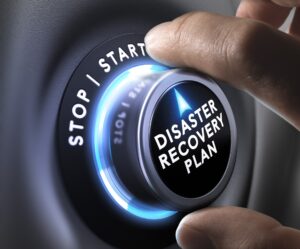Does your lab have a disaster plan?
You may have excellent systems in place. You and your staff work as safely as possible. But despite your precautions, there’s always a possibility that something may go horribly wrong.
 That’s why having a disaster plan in place is so important. While it may not be a specific requirement of ISO standards it will add to your peace of mind and is a natural outcome of a well designed and implemented risk management system.
That’s why having a disaster plan in place is so important. While it may not be a specific requirement of ISO standards it will add to your peace of mind and is a natural outcome of a well designed and implemented risk management system.
We’re written about cybersecurity before but unfortunately there are other things that could go wrong. Here are some ways that you can prepare and protect your lab from disasters.
Identify your most critical functions
If a disaster strikes, resources may be limited. That’s why it’s important to know which functions are the most important to your lab. This will help you allocate resources to those functions and get you up and running faster.
Cross training of staff could be part of this. If staffing shortages become a problem, having staff who are knowledgeable in other areas will help maintain continuity.
Take good photos
Having evidence of your equipment and facility will help with insurance claims. Photos are a great way of recording this information.
Those photos should include close ups of equipment as well as wide-angle shots of the rooms. This will demonstrate the condition of the space and the equipment prior to the disaster.
Don’t forget to keep these images current. If you purchase new equipment, remember to add photos of this as well.
Keep your data in the cloud
 If you store all your information, SOPs, and protocols on hard drives in your lab, this can all be damaged or destroyed.
If you store all your information, SOPs, and protocols on hard drives in your lab, this can all be damaged or destroyed.
Although you can store some data locally, it’s s good idea to back up the lab’s computer records in the cloud.
Train all of your staff in this process. Check records on a regular basis for accessibility and completeness.
If you do store documents and records in the cloud, bear in mind the provisions of clause 7.11.4 of ISO 17025 or clause 5.10.3 of ISO 15189, if you are a medical lab.
Contact lists
If disaster strikes, you’ll need to be able to communicate with your staff and colleagues. Highlight the details of those who have agreed to be designated critical function operatives. Be sure to contact them first.
Practise this contact process. Depending on the number of people involved, you may like to have one or two contact leaders. You could consider a phone tree, but these have limitations. For a larger lab or organisation, an automated emergency contact system would be the best option.
Maintain current chemical lists
If a fire begins in the lab, firefighters may not enter if they don’t know what kind of chemicals are in there.
Keeping a chemical inventory or manifest outside the lab makes good sense. Although you could keep a copy of this at the lab entrance, smoke and heat could render this invisible.
Another option could be to provide this list to your local fire service or have a designated person communicate this information. In fact, depending on the nature of your business, you might be obliged to provide this information to emergency services. Go to https://www.safeworkaustralia.gov.au/registers-manifests-and-placards to find out more information.
If your lab doesn’t have any hazardous materials, this information could mean the difference between losing the contents of a lab or saving them.
Use emergency power
If your lab requires fridges and freezers, consider keeping them plugged into emergency power outlets. These will continue to function when normal power goes out.
However not everyone has access to this type of power and some organisations may not have backups at all.
Part of your plan should include deciding what you need to keep in your fridges and freezers. An alternative for items that need to remain frozen could be storing them temporarily in liquid nitrogen if these lower temperatures will not have an adverse effect on the item.
If your lab uses liquid nitrogen for cool storage, ensure these storage systems are kept at an adequate level. Keeping backup liquid nitrogen is also a good idea.
Testing and training
 Once a disaster strikes, it’s too late to check if your alarm system works.
Once a disaster strikes, it’s too late to check if your alarm system works.
You may have an alarm monitoring system that notifies staff about pending equipment failures. This system should provide sufficient time for staff to arrive at the lab and save the samples or equipment.
There’s no point alerting someone who doesn’t have 24-hour access if something goes wrong at midnight on a Saturday. Keep contact details current and ensure that the correct person with authority and access to the lab is notified.
Test fire and smoke alarms regularly. Your equipment provider should be able to help with this.
Employees should have training in your disaster plan. Include this in induction programs for new employees.
As part of your testing, you should also run fire drills including building evacuation. This will give everyone the opportunity to practice emergency duties and procedures and evaluate the effectiveness of your plan. Do this at least annually.
Consider critical samples
If you have unique and irreplaceable samples you need to protect these.
Do you have collaborators in other parts of the country where you can safely store these samples? If not, investigate commercial organisations that can do this for you.
Storing samples offsite will prevent the complete loss of these exclusive materials.
A final word
While we truly hope that your lab won’t face a disaster, having a plan in place will reduce your anxiety if the worst happens.
Government organisations such as the NSW Small Business Commissioner provide excellent resources that can help you develop a comprehensive plan. You could also review the AS 3745:2010 Planning for emergencies in facilities Standard for further guidance.
And of course, if you’d like to discuss a risk management plan or any part of your lab management system, we’re here to help.
You can call Maree on 0411 540 709 or email info@masmanagementsystems.com.au and request a confidential discussion.
Remember, you don’t have to do this alone!
Download the article Does your lab have a disaster plan?





